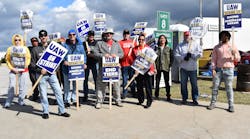Ford, UAW reach tentative agreement: UAW calls deal 'lucrative' and 'historic'
On days 38 and 39 of the strike against the Big Three, the United Auto Workers made a concerted effort to “amp up the pressure” by hitting the largest, most profitable plants at Stellantis and General Motors, according to UAW President Shawn Fain. These shutdowns halted production at the Ram Assembly Plant in Sterling Heights, Michigan, and GM’s Arlington, Texas plant and removed 11,800 more workers from the production lines. A total of 45,000 UAW workers were on strike at Big Three plants since Sept. 15.
On day 40, not wanting to see how much further the UAW would go, Ford and the UAW tentatively agreed on a historic collective bargaining agreement that will allow 20,000 UAW members to return to work at Ford plants, including its largest and most profitable—the Ford Kentucky Truck Plant, where a strike two weeks prior halted production of the Ford F-Series Super Duty trucks.
“Ford knew what was coming for them on Wednesday if we didn’t get a deal. That was checkmate,” asserted a cool and confident Fain on a recorded video.
In a general release, Ford CEO and President Jim Farley stated: “We are pleased to have reached a tentative agreement on a new labor contract with the UAW covering our U.S. operations. Ford is proud to assemble the most vehicles in America and employ the most hourly autoworkers. We are focused on restarting Kentucky Truck Plant, Michigan Assembly Plant and Chicago Assembly Plant, calling 20,000 Ford employees back to work and shipping our full lineup to our customers again.”
There are still a few steps left before Ford and the UAW can officially end the recent strife, with the last being a vote by membership to seal the deal, but nothing is certain. Earlier this month UAW members rejected the tentative CBA that UAW leadership reached with Mack Trucks. This pending deal with Ford does seem to achieve Fain’s goal of getting “every penny possible” from Ford.
“UAW members at Ford will receive more in straight general wage over the next four and a half years than we have over the last 22 years combined,” noted UAW Vice President Chuck Browning.
Over the course of the new deal, UAW members would receive four times the value of the previous 2019 CBA. These gains include:
- 25% general wage increase over the course of this agreement
- Immediate 11% wage increase for Ford workers upon ratification
- 68% starting rate increase
- 30% top-rate increase
- 150% raise for temporary works over course of contract
- Immediate 85% wage increase for lower-tiers at Sterling Axle and Rawsonville plants upon CBA ratification
“Thanks to the power of our members on the picket line and the threat of more strikes to come, we have won the most lucrative agreement per member since Walter Reuther was president [from 1946-1970],” Browning said, adding, “This contract is going to be life changing.”
The wage hikes, which account for cost-of-living-adjustments, allow Ford workers to make at least $28/hour, with top wages cresting $40/hour. The UAW made gains with pensions, retirement, and 401k, as well as overall job security, Browing said.
“For the first time ever, we won the right to strike over plant closures,” he reported. “That means they can’t keep devastating our communities and closing plants with no consequences.”
The next steps include a vote by the UAW National Ford Council on if they should send the vote to members, then a public review of the deal, meetings with local leadership, who will then meet with local members before a vote.
There are still 25,000 GM and Stellantis workers on strike.
“We are calling on all Ford strikers to go back to work while we vote on our tentative agreement. Like everything we’ve done in this stand-up strike, this is a strategic move to get the best deal possible,” Browning said. “We’re going back to work at Ford to keep the pressure on Stellantis and GM. The last thing they want is for Ford to get back to full capacity while they mess around and lag behind.”
During a previous public statement, Fain mentioned Ford’s Rouge River Complex, where the OEM builds its most popular vehicle, the F-150 pickup truck. This site was also where the company’s executive chairman, Bill Ford, recently called for the UAW to end the strike, citing Ford’s partnership with the union and contrasting it with non-union automakers.
“The UAW’s leaders have called us the enemy in these negotiations. But I will never consider our employees as enemies,” Ford said. “This should not be Ford versus the UAW. It should be Ford and the UAW vs. Toyota and Honda, Tesla, and all the Chinese companies that want to enter our home market.”




